by Winding Pathways | Mar 17, 2022 | (Sub)Urban Homesteading, Garden/Yard, Garden/Yard
As we watched squirrels gleaning sunflower seeds from feeders in our backyard, we dined on 2021s sunshine!
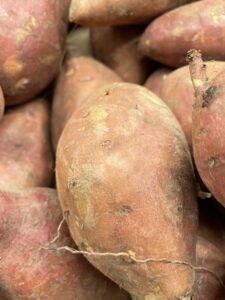
Sweet potatoes are a healthy vegetable.
Thanks to last season’s sun our crop of sweet potatoes produced a bountiful crop, and we ate them until our last one became part of our February 8th dinner. We’ve only been growing sweet potatoes for a few years because we’d heard they need a long southern summer to mature. We now know that’s not true.
We love sweet potatoes. They come in many varieties and color shades from white to purple and the common ones with deep orange flesh. This nutritious plant originated from tropical South America and is now grown in warm regions all over the world. Sometimes they are called yams, but these two plants are distinctly different. Yams originated in Africa.
Nutritious Vegetable
We love the taste and nutrition of sweet potatoes but here are some other ways we love this plant:
- They are easy to grow. We buy “slips” and plant them in late May or early June.
- The plants and flowers are gorgeous, and slips are sometimes sold as ornamentals.
- They store well. We carefully dig them before the first frost, let them cure for a couple of weeks, and then store them in a cool dark place. They last all winter.
Sweet potatoes are easy. No freezing or canning is needed. We plant, weed a bit, dig, cure, and store and then enjoy eating them all winter. This year we’ve ordered a variety of sweet potato slips from Sand Hill Preservation Center and look forward to a larger harvest. The company also sells heritage chicken breeds and vegetable seeds.
by Winding Pathways | Jan 5, 2022 | (Sub)Urban Homesteading, Flowers/Grasses, Garden/Yard, Garden/Yard, Nature
A raging blizzard roaring over Winding Pathways just before Christmas 2022 showed us the power of HARVESTING SNOW. We love catching it. Other parts of the country endure blizzards, especially Nor’ Easters
Well, we didn’t really catch the snow, but our prairie did. It has a talent for harvesting snow and other forms of moisture. It taught us how prairie and other taller plants – grasses, forbs, shrubs, vines, and trees – help themselves grow next summer.
Our prairie has a thick growth of two-foot-tall dead stems from last summer’s growth. Each stalk is brittle, but thousands of them working together slowed the wind just enough for it to drop the snow it had swept off nearby lawns and roads.
The deep drift that settled on our prairie will melt and give next spring’s plants a jumpstart in moist soil. Nearby shortly sheared lawns can’t catch snow and will start the spring on dryer soil. Nature delivered irrigation water to our yard for free!
Sharing Nature’s Wisdom
In dry regions of the country, snow also helps next summer’s vegetables. During college, Rich worked weekends at an Idaho ranch. He was surprised one January when Lucille Pratt, part owner of the land and an outstanding vegetable gardener, asked him to shovel a snow drift from nearby onto the garden.
For a Jersey boy, this seemed like a weird request. He did as asked and learned that melting snow oozed water into the soil. That helped get the vegetables going come spring and sustained them through the dry north Idaho summers.
Snow may be a bother to some, but it’s also a blessing to dry soil and the plants it sustains.
Over two blizzardy days, our prairie gently caught snowflake after snowflake. We already are looking forward to bright prairie flowers dancing in next summer’s breeze. Thanks, prairie for harvesting snow. Nature’s wisdom to catch winter’s snow and help next summer’s growth is amazing.
-
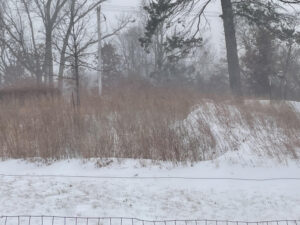
-
Capturing snow.
-
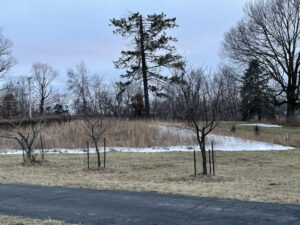
-
Three days later, a rapid melt left the ground bare, except where prairie plants held snow.
by Winding Pathways | Dec 9, 2021 | Garden/Yard, Nature
Meeting a Challenge
A few years ago, we received an email from the National Wildlife Federation asking us, and millions of others, to camp in the backyard once during the summer.
Upping the Ante
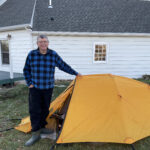
November makes 12.
We took it to heart and then went further. Over the past twelve months, Rich and occasionally Marion camped out at least once a month. The first time was on an unusually mild December night in 2020. The last one as November 2021 ended. In brilliant sunshine, Rich set up his backpack tent about 20 feet from the garage and spent a night punctuated by coyotes and owls vocalizing in nearby woods. The night completed his camping every month for the past year.
Some months – like in the dark of winter – Rich tented in the back yard. After an evening of reading or watching a Great Courses DVD Rich bid “Good night” and stepped into the cool evenings, snuggled into the thick sleeping bag – preheated with “Hot Hands” packs, and enjoyed the evening serenades.
Watching the Weather
January and February 2021, Rich camped back to back. The predictions were mild for January 31st and February 1st. And, cold was on its way. So, Rich pushed away snow and set up his tent next to the barn where the chickens sleep. He was aroused at 4:00 a.m. when the light we use to wake the birds did just that. Between the bright light shining in his tent and the rooster’s crowing Rich gave up and came in about 4:30 a.m. Still, the overnight counts!
Combining Interests
In warmer months when fishing beckoned, he would head to NE or SE Iowa and come back with a string of trout or panfish.
The few times we traveled further afield, we tented – March in Kansas with the campground to ourselves; September and October in the East under beautiful stars and in the pouring rain.
Why Backyard Camp?
Backyard camping is great fun, even in a tiny urban yard. It also has these advantages over trekking to a distant state or national park:
- Spontaneous decision. No need to take time off work or school. Just set up the tent behind the house, add a sleeping pad and bag, and camp.
- Choosing the weather. If it’s cold, hot, windy, rainy, or (gasp) snowy, wait for a more pleasant night.
- No camping fee or need to drive anywhere.
- Easy to drag in many blankets and pillows that might not be taken on a camping trip somewhere.
- During winter’s long dark nights just stay inside to watch tv or read before sleeping in the tent.
- It’s an adventure….at least for kids.
-
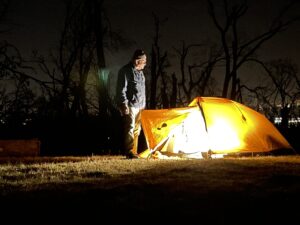
-
First of 12 tentings.
-
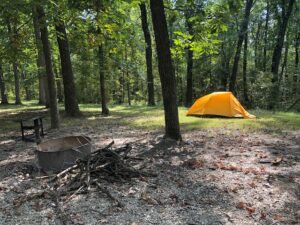
-
Summer camping is easy.
-
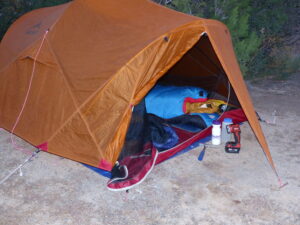
-
Sometimes we use cots for more comfort.
-
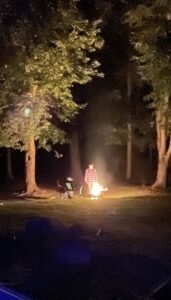
-
A Campfire adds a cozy feel.
With 12 months down, will Rich’s streak of every month camping continue????? We’re not sure, but likely it will.
by Winding Pathways | Dec 2, 2021 | (Sub)Urban Homesteading, Foraging, Garden/Yard, Trees
On a windy cold Thanksgiving afternoon, we did something nutty. After tossing buckets and shovels into our pickup we drove north until we spotted greenish foliage popping through the road ditches dry grass.
There, we rescued six red cedar trees that are now at home in our yard.
A Hardy Tree
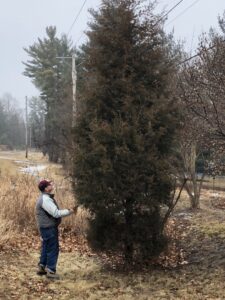 Few American trees have such a love-hate relationship with people as the red cedar, which is actually a Juniper. Perhaps it’s unpopular because of the plant’s amazing adaptability. Sure, it needs full sunlight but given that it thrives in heat, salty roadsides, and terrible soil it is one hardy plant! Even stiff grass competition that snuffs out other baby trees doesn’t seem to bother it.
Few American trees have such a love-hate relationship with people as the red cedar, which is actually a Juniper. Perhaps it’s unpopular because of the plant’s amazing adaptability. Sure, it needs full sunlight but given that it thrives in heat, salty roadsides, and terrible soil it is one hardy plant! Even stiff grass competition that snuffs out other baby trees doesn’t seem to bother it.
Red cedars thrive from the Great Plains eastward to the Atlantic Ocean. In many places they are small bushes, but sometimes the tree grows big enough to interest loggers. The aromatic wood is used to craft cedar chests, closet linings, and even pencils. Fence posts made of it last for decades.
Why Ranchers and Farmers Dislike Cedars
Ranchers curse cedars because they spread in pastures. Cattle don’t like dining on prickly cedar twigs, and within a decade or two cedars replace the grassy food that cows love with a green desert of scrubby trees.
What’s to Love About Red Cedars
But, a cedar grove isn’t really a desert. Birds, especially cedar waxwings, love eating their tiny blue berries, and dense stands of cedars protect many species of wildlife from howling wind, searing sun, and predators.
There’s more. We live in Cedar Rapids, a city named for the rugged trees that grow in rocky bluffs over the Red Cedar River. They’re small and twisted but some are over 400 years old.
We planted our cedars on the edge of our property where they will form a screen from the wind and passing car headlights. They also will give us privacy, and be a safe home for birds that visit our feeders.
In mid-December, we’ll return to the road ditch and cut a six-foot red cedar for our Christmas tree. Cedars are scraggly and unsymmetrical, but we don’t put our tree up in the house. It will grace the Holiday season on our back deck. Pouring a few cups of sunflower seeds in its foliage creates a living stream of ornaments as goldfinches, chickadees, cardinals, and nuthatches come and go.
For information on red cedars and many other trees visit the website of the National Arbor Day Foundation.
-
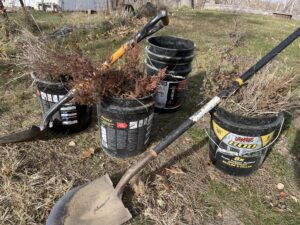
-
We rescued seedlings to plant for screens in our yard.
-
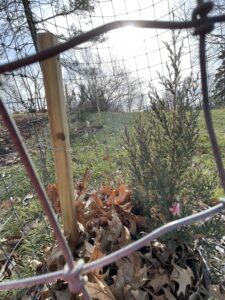
-
We remember to protect the seedlings.
by Winding Pathways | Oct 28, 2021 | (Sub)Urban Homesteading, Flowers/Grasses, Garden/Yard, Garden/Yard, Nature, Trees
A camera is an outstanding tool to see change. Plant a tree or prairie and it grows so glacially slowly that noting change is hard. Photos help by compressing time.
In August 2020 a derecho felled 47 of our 53 mature trees. We spent much of last fall converting them into firewood and piling up brush. Knowing that the land would be sunny after years of leafy shade, we planted a blend of savanna wildflowers last November.
The area didn’t change much from last fall until April of this year. Then nature put on a glorious show. Here are three photos of our yard taken in April, May, and September 2021. Most of the growth didn’t come from the seeds we planted last fall. Seeds long dormant in the soil sprouted with enthusiasm once they sensed the sun’s springtime warmth.
-
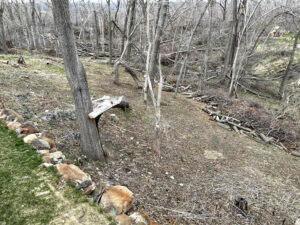
-
For over eight months the land lay waiting and still.
-
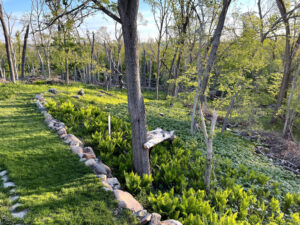
-
Ferns and Mayapple emerged strongly and yielded to more open woodland plants.
-
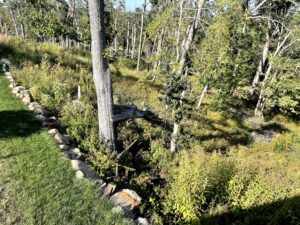
-
The seeds had waited dormant for the right conditions.
by Winding Pathways | Oct 14, 2021 | (Sub)Urban Homesteading, Chickens, Garden/Yard, Garden/Yard, Hoover's Hatchery, Nature
As we entered our driveway a frustrating sight greeted us. We were looking forward to picking the enormous seed heads of sunflower plants towering over the garden. Not this year. While we were gone, a windstorm toppled them a few weeks before they’d ripen.
That’s the way it is with gardening. Sometimes there’s a great success resulting in delicious meals. Then there are flops, like our sunflowers. We found more wind mischief. Several almost ripe pumpkins and squash had broken stems, dooming them to rot instead of ripening.
A Silver LIning
All wasn’t lost. We pitched the sunflower heads, pumpkins, and squash into our chicken run. Enthusiasm erupted as the hens eagerly devoured them. They pecked a hole in the squash and pumpkins, ate all their seeds, and then made quick work of eating the soft interior flesh. Soon all that remained was the tough outer skin of the pumpkin and the sunflower’s now seedless head. These went into the composter.
Chickens love garden debris and vegetables that don’t quite make it to our table. When fall closes down our garden we turn in the chickens. They chow down on bugs, weed seeds, and unripe vegetables. This makes clean-up easier and probably reduces next year’s insect and weed problems. A few days after Halloween our hens love snacking on our shriveling Jack O Lantern. They also relish seeds scooped out of winter squash and most vegetables left in the refrigerator a bit too long.
It was frustrating losing our sunflowers, pumpkins, and squash. Thanks to our industrious hens we were able to put them to good use.
-
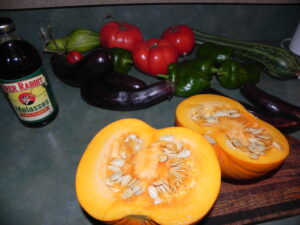
-
Seeds ready to eat.
-
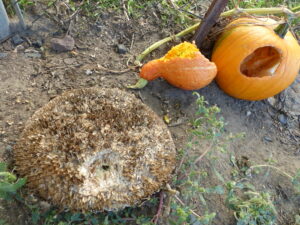
-
Holes pecked in pumpkin.









 Few American trees have such a love-hate relationship with people as the red cedar, which is actually a Juniper. Perhaps it’s unpopular because of the plant’s amazing adaptability. Sure, it needs full sunlight but given that it thrives in heat, salty roadsides, and terrible soil it is one hardy plant! Even stiff grass competition that snuffs out other baby trees doesn’t seem to bother it.
Few American trees have such a love-hate relationship with people as the red cedar, which is actually a Juniper. Perhaps it’s unpopular because of the plant’s amazing adaptability. Sure, it needs full sunlight but given that it thrives in heat, salty roadsides, and terrible soil it is one hardy plant! Even stiff grass competition that snuffs out other baby trees doesn’t seem to bother it.





